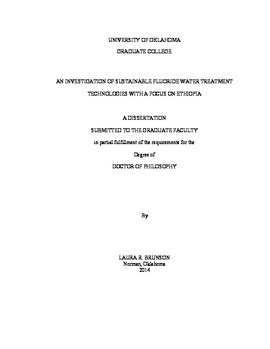| dc.description.abstract | Human consumption of unsafe drinking water from an unimproved source is a global issue affecting approximately 748 million people worldwide. While this number has been decreasing in recent years, an additional 1.2 billion people are estimated to lack access to water that is consistently free from health risks. This dissertation begins with a literature review investigating drinking water improvement initiatives around the world and a discussion of reasons why these initiatives often fail. Resources are provided for researchers and practitioners working on drinking water treatment implementations and examples of implementations that have failed or succeeded are discussed. The conclusion from this review is that global drinking water solutions will be more effective when designed and implemented by personnel from multiple disciplines. For example, people in several fields, including: social sciences, engineering and business, should collaborate and share ideas and expertise. Ideally this collaboration should start at the genesis of a project and continue through implementation and follow up. There is hope that the synergistic efforts of multidisciplinary teams will help to increase the number of successful water initiatives.
Next the dissertation focuses on the problem of elevated fluoride concentrations in drinking water. Naturally occurring fluoride is the second largest issue contributing to the global water crisis. It is estimated that globally over 200 million people are affected by elevated concentrations of fluoride in drinking water. The goal of the technical portion of this dissertation is to investigate locally available and sustainable materials that can be used to remove fluoride from drinking water, with a focus on Ethiopia and eastern Sub-Saharan Africa. Bone char is very effective as an adsorptive material, but is not always accepted by communities due to religious or cultural beliefs. Therefore, this research evaluated methods to improve the fluoride removal capacity of bone char as well as investigated materials that might serve as a replacement for bone char in appropriate communities. Eucalyptus trees are prevalent in Ethiopia where a large fluoride problem exists, and thus, eucalyptus wood char was investigated as a potential substitute for bone char. This dissertation studied wood char produced from Eucalyptus robusta as an adsorption material to remove fluoride from water, thereby making it safe for consumption. Although the use of eucalyptus wood char alone removed minimal fluoride, when it was amended with aluminum and iron oxides it evidenced much higher fluoride removal capacities. Metal oxides, produced from starting materials such as aluminum sulfate and iron (III) nitrate, were used to amend the wood char. Metal amendments resulted in fluoride removal capacities ranging from 3 to 50 times higher than wood char without amendment. The combination of wood char and metal oxide amendment is synergistic because the wood char provides a matrix with a high specific surface area for the metal oxides to adhere to while the metal oxide amendment increases the electrostatic attraction of the char surface for fluoride. Additionally, wood char was pretreated with oxidizing agents such as hydrogen peroxide and potassium permanganate prior to metal amendment. These pretreated and metal amended chars were found, in most cases, to have increased metal loading rates and, in some cases, higher fluoride removal capacities.
This dissertation also looked at ways to improve the adsorption effectiveness of bone char for communities where bone char is an acceptable material for drinking water treatment. Amending bone char with aluminum nitrate showed an increase in fluoride removal at high equilibrium concentrations but not at low equilibrium concentrations close to the WHO recommended value for fluoride (1.5 mg/L). Select fluoride removal materials, including aluminum impregnated wood char, activated alumina, bone char and aluminum amended bone char, were studied in the field using groundwater from a well in a rural Ethiopian community. Field results suggested that the combination of elevated groundwater pH along with competing ions such as sulfate (both common in ground waters of the Ethiopian Rift Valley) affected the fluoride removal capacities of the materials studied, particularly the aluminum impregnated wood char. Finally, this research tested the validity of the Rapid Small Scale Column Tests (RSSCT) principles for bone char adsorbing fluoride from water. These experiments indicated that RSSCT principles are applicable for bone char; use of this approach can result in large time and cost savings to researchers and implementers. Overall, this dissertation provides several conclusions that are practically helpful to researchers in the field and also foundational research on which future studies can build to continue efforts to find sustainable and appropriate fluoride removal technologies. | en_US |
